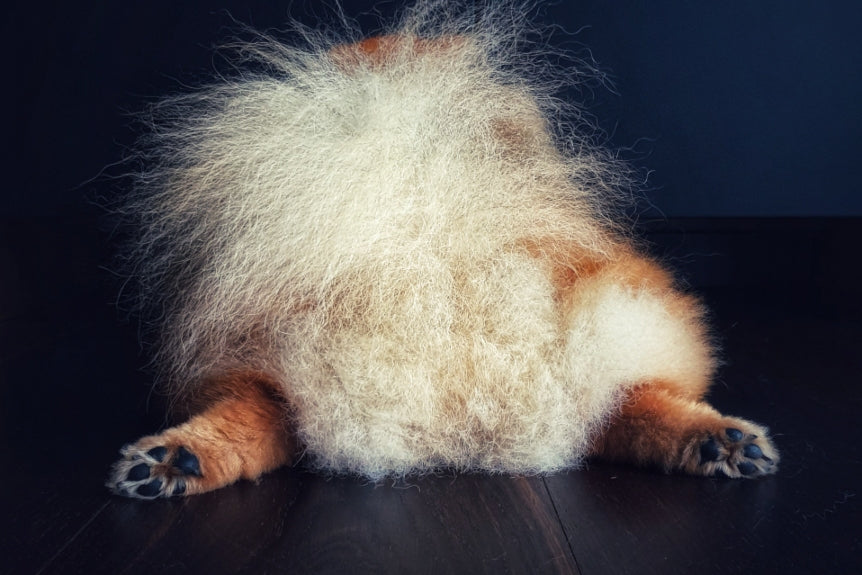
How To Stop Dog Bleeding From Butt? (2024 Updated)
Share
Dogs eat all manner of things, which affects their gastrointestinal tract sooner or later. While this can lead to slight discomfort, it can also be more severe (in the case of tumors or toxicity). This article will discuss why your dog is bleeding from the butt, the consequences of this bleeding, and solutions to treat this condition in the year of 2024.
Why is your Dog Bleeding from the Butt?
It is discomforting or even alarming when a dog is bleeding from its rear end. The dog is not only in pain, but they will also be restless, and their bloody mess will be all over your house or all over their cage. In addition, rectal or anal bleeding is usually followed by vomiting and loss of appetite. So what does make dogs bleed from their butt?
Rectal bleeding in dogs may be because of a condition referred to as Hemorrhagic Gastroenteritis. This is inflammation and bleeding in the digestive tract. It's also referred to as bloody diarrhea. Though some experts say rectal bleeding is caused by constipation, others assert that there's no known cause. However, known risk factors for rectal bleeding are hyperactivity and stress.
On the other hand, a more likely cause of the dog bleeding from the butt is Hematochezia. This condition defines blood (with or without feces) coming out from the anus. While this may not be enough to conclude that it's Hematochezia, other indications make it crystal clear.
They include:
- Loose feces that are either mixed with blood or on its surface
- Slime or mucus in the feces
- Rectal polyps
- Discolored feces
- Solid feces with blood on its surface
- Droplets or streams of blood
- Straining when stooling
Thanks to extensive research, there are multiple known causes of your dog bleeding from the butt. They are listed below:
- Colitis (inflammation of the colon)
- Foreign objects
- Rectal Polyps (tumors or cancer)
Colitis is the most common reason typically triggered by bacterial overgrowth, inflammatory bowel disease, parasitism, and food allergy. Rectal polyps and tumors are more common among middle-aged and older dogs (seven years and older). Rectal polyps can be in two forms: multiple or single. Usually, they are harmless, but they can result in tumors as well.
Rectal polyps usually occur in the digestive tract of your dog, but they're most commonly detected in the rectal-anal area tract.
The Consequences of Dog Bleeding from the Butt
These conditions are fairly common among dogs, significantly smaller breeds. Their stool is so bloodied that it looks like raspberry jam. These conditions can dehydrate or debilitate your dog within a very short period. However, if left untreated, it can be a severe health issue for your dog.
How to Treat It?
Ideally, you should treat your dog following the symptoms shown. Laboratory work and imaging helps to determine if surgery is necessary. Unfortunately, dogs bleeding from the butt can't be appropriately treated if the cause is unknown. That's why diagnosis is essential (more on this later).
1. Nausea Medications, Antibiotics, and IV Fluid
If Hemorrhagic Gastroenteritis is the cause of your dog's bleeding from the butt, the necessary treatment for that will be ample use of intravenous fluid to restore the lost fluid component in the blood. This should be followed with antibiotics and nausea or anti-vomiting medications. Antibiotics can help eliminate the harmful bacteria present in their digestive tract. A veterinarian carries out this treatment, and it will require many days of hospitalization.
This treatment is very effective and helps to rehydrate your dogs and aid their recovery within a few days. However, if the IV fluid is not aggressively administered, this treatment won't be effective because hemorrhagic Gastroenteritis causes severe dehydration.
Many veterinarians believe that antibiotics should be used for more severe cases, for instance, to treat low immunity to diseases and prevent antibiotic resistance.
2. Probiotics
In the case of Hematochezia, the veterinarian can begin by slowly introducing probiotics to your dog's meals. The foods included in the diet are usually mild on the intestinal tract and reduce your dog's discomfort. Probiotics will make sure that beneficial bacteria are present in the gastrointestinal tract of your dog to recreate the natural balance. If the veterinarian suspects the presence of parasites in the digestive tract, a deworming medication will be administered to your dog.
3. Yunnan Baiyao Herbal Supplement
This is a Chinese herbal medication, and it's 100% organic. It's the perfect medicine for any bleeding-related condition, whether it's external or internal. It's quick and effective in stopping acute blood loss. Yunnan Baiyao is quite popular and can be purchased on online retail stores like Amazon. This medication is not exclusively for dogs. It's suitable for other mammals such as cats, humans, and horses.
Yunnan Baiyao is also not a recently manufactured medicine, and it has been around for more than 100 years. Yunnan Baiyao is available in both powder and capsule form. For correct dosages, the capsule form of this medicine is recommended. The powder form of this medicine can be applied topically, while you can apply the capsule form orally.
Yunnan Baiyao has a rich history. During the Vietnam war with the U.S, the Vietcongs used Yunnan Baiyao to save many of their soldiers on the battleground. Veterinarians and other medical experts recommend the usage of Yunnan Baiyao to treat bleeding. There are numerous positive reviews from users who narrated how Yunnan Baiyao saved their pets from life-threatening bleeding conditions.
The usage of this medicine has multiple benefits, including:
- Enhance blood circulation
- Lessens or stops bleeding
- Reduces swelling
- Alleviates pain
- Detoxification
- Lessens blood stasis
- Clots blood very quickly
- Reduces inflammation
Dosage
There's no uniform dosage for dogs suffering from this condition. Weight is a determinant factor for accurate dosage. Dosages include:
- One capsule once per day for dogs weighing 10 pounds and below
- One capsule twice per day for dogs weighing between 10 and 30 pounds
- Two capsules twice per day for dogs between 30 and 60 pounds
- Two capsules thrice per day for dogs weighing 60 pounds and above
Usage
The capsule should be orally administered. This treatment should be given on alternating days, not daily. This means you'll give the medications every two days or on and off for five days. Usage of this drug should be monitored and given under expert supervision. The reason is that the usage of this drug consistently for a long time can enhance liver markers.
A unit of Yunnan Baiyao contains 16 capsules, and each of them weighs 0.25 grams.
Other Conditions Yunnan Baiyao Can Treat
Yunnan Baiyao is an anti-bleeder, so it's not limited to treating rectal bleeding in dogs. Other conditions it can treat include:
- Bleeding dogs' toenails
- Dog's nose bleeding
- Scrapes or cuts
- Bleeding gums
- Petechiae and ecchymoses
- Hyphens (trauma or canine retinal bleeding)
- Hemoabdomen
- Chronic bleeding
- Hemangiosarcoma
- Chemotherapy-induced bleeding
- Hematoma
- Pre and Post-Surgery
- Heavy periods
- Bleeding disorders
When to Discontinue Usage of Yunnan Baiyao?
Yunnan Baiyao is entirely organic, making it safe to use and with few side effects. However, you must take certain precautions and shouldn't administer this medicine under certain circumstances.
- Please don't feed your dog broad beans, sour food, or fish within 24 hours of treating them with Yunnan Baiyao.
- Stop using the medicine if your dog is displaying an allergic reaction to it.
- Discontinue usage of the drug if your dog's condition is showing no improvement or becomes worse after 72 hours.
Diagnosis
Diagnosing Hemorrhagic Gastroenteritis is pretty clear-cut. The stool's description, acute bleeding, and a basic blood test known as PCV (packed cell volume) are necessary to diagnose this condition. Packed cell volume is simply the measurement of the amount of red blood cells in a sample of blood. You can carry out this test using a few drops of your dog's blood.
If your dog has a packed cell volume surpassing 60%, this means that they are severely dehydrated. The reason for this dehydration is the loss of a significant amount of the fluid component in the blood flowing into the intestinal tract. The stool of your dog is usually examined with the aid of a microscope to search for Clostridium (a bacteria).
While it hasn't been conclusively proved that the presence of Clostridium in the body triggers Hemorrhagic Gastroenteritis, it's widely known to be associated with it.
The rectal-anal polyp is the most popular tumor found in the intestinal tract of dogs. Most rectal polyps occur around 2cm of the anus, and once they're big enough, they can be detected via touch during a rectal examination. Once rectal polyps are detected, the recommended course of action is usually Colonoscopy to ensure that the tumors don't spread further inside the colon.
Final Thoughts
Rectal-anal bleeding in your dogs should receive the immediate attention and checkup of your veterinarian. Also, ensure that you follow their prescriptions and recommendations on the treatment of choice when your dog is bleeding from the butt. These conditions can be unique to each dog and may require different forms of treatment. In some instances, surgery may be necessary.
